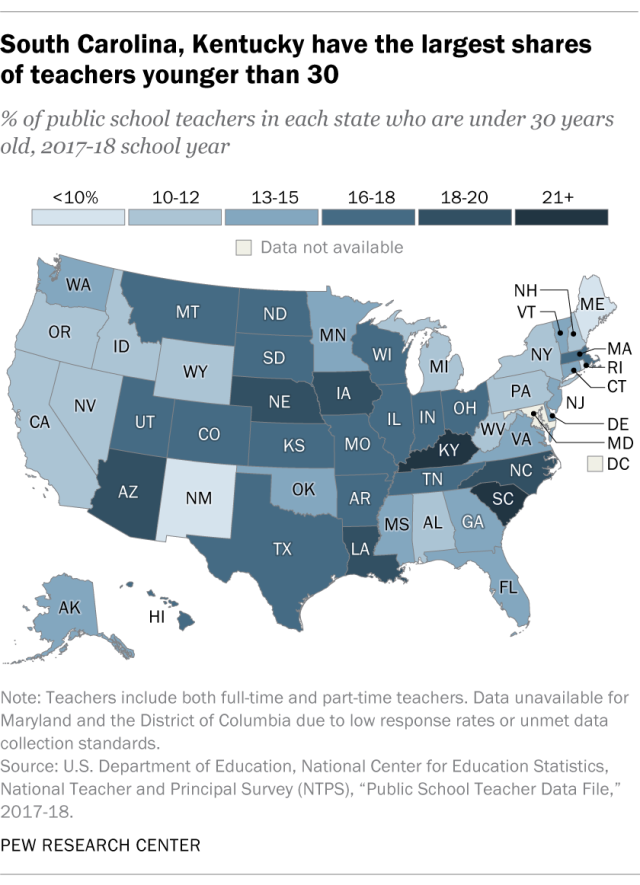Fewer U.S. school grads are getting training levels

The coronavirus pandemic has introduced a number of challenges for the nation’s Ok-12 colleges, together with widespread experiences of trainer shortages as the brand new faculty 12 months begins. However the issue of attracting individuals to the career isn’t essentially a brand new one. Even earlier than the pandemic, there have been indicators of a “pipeline downside” among the many nation’s educators.
Each the quantity and share of latest school graduates with a bachelor’s diploma in training have decreased over the previous couple of many years, based on knowledge from the Nationwide Middle for Training Statistics (NCES). That has occurred whilst the general quantity and share of Individuals with a school diploma have elevated.
To evaluate the decline in training bachelor’s levels conferred over time and the variations in youthful academics’ experiences, this Pew Analysis Middle evaluation makes use of federal knowledge to investigate adjustments in these teams.
The evaluation attracts on greater than three many years of knowledge from the Built-in Postsecondary Training Knowledge System (IPEDS), and survey knowledge from the Nationwide Middle for Training Statistics (NCES) and the Nationwide Instructor and Principal Survey (NTPS), previously referred to as the Colleges and Staffing Survey. The evaluation of conferred training levels over time attracts from 5 many years of IPEDS diploma conferral knowledge from all postsecondary establishments, which embrace faculties, universities and occupational and vocational colleges.
The evaluation of U.S. academics’ age distribution makes use of the newest NTPS knowledge accessible (the 2017-18 faculty 12 months). Knowledge was unavailable for Maryland and the District of Columbia as a result of low response charges or unmet knowledge assortment requirements. NTPS knowledge consists of each full-time and part-time public faculty academics.

In 2019-20, the newest 12 months with accessible knowledge, faculties and universities conferred 85,057 bachelor’s levels in training, about 4{4d1962118177784b99a3354f70d01b62c0ba82c6c697976a768b451038a0f9ce} of the greater than 2 million complete levels issued that 12 months. That was down 19{4d1962118177784b99a3354f70d01b62c0ba82c6c697976a768b451038a0f9ce} from 2000-01, when faculties and universities issued greater than 105,000 bachelor’s levels in training, or roughly 8{4d1962118177784b99a3354f70d01b62c0ba82c6c697976a768b451038a0f9ce} of all undergraduate levels.
The lower is much more pronounced when the long run. Through the 1970-71 faculty 12 months, training was the most well-liked discipline for U.S. undergraduates. Schools and universities issued 176,307 bachelor’s levels in training that 12 months, or 21{4d1962118177784b99a3354f70d01b62c0ba82c6c697976a768b451038a0f9ce} of all levels conferred.
Ladies, particularly, have grow to be a lot much less doubtless to decide on training as their discipline of examine. Greater than a 3rd (36{4d1962118177784b99a3354f70d01b62c0ba82c6c697976a768b451038a0f9ce}) of all bachelor’s levels conferred to ladies have been in training in 1970-71. By 2019-20, simply 6{4d1962118177784b99a3354f70d01b62c0ba82c6c697976a768b451038a0f9ce} of the undergraduate levels awarded to ladies have been in training.
Amongst each women and men, faculties and universities now difficulty much more levels in enterprise and well being professions (and associated applications) than in training. Enterprise and well being levels accounted for the 2 largest shares of all bachelor’s levels conferred in 2019-20 at 19{4d1962118177784b99a3354f70d01b62c0ba82c6c697976a768b451038a0f9ce} and 13{4d1962118177784b99a3354f70d01b62c0ba82c6c697976a768b451038a0f9ce} of the overall, respectively.
Whereas a substantial proportion of Ok-12 academics have bachelor’s levels in training, it’s not all the time a requirement for the job so long as potential academics full crucial coaching and certifications. Along with the decline in school graduates receiving levels in training, nonetheless, trainer preparation applications have seen a steep decline in enrollment lately. And 44{4d1962118177784b99a3354f70d01b62c0ba82c6c697976a768b451038a0f9ce} of U.S. adults say they’re by no means more likely to encourage a youngster to grow to be a Ok-12 trainer, based on NORC on the College of Chicago.
Consultants have raised a number of prospects for why fewer individuals are expressing curiosity within the career, together with excessive ranges of stress and burnout, low wages which have remained stagnant, and concern in regards to the political and ideological arguments surrounding classroom curriculums.
With fewer school graduates acquiring levels in training, youthful academics have declined as a share of the nation’s general elementary and secondary faculty instructing workforce. In 2017-18, the newest faculty 12 months for which NCES has printed knowledge on this subject, 15{4d1962118177784b99a3354f70d01b62c0ba82c6c697976a768b451038a0f9ce} of all private and non-private faculty Ok-12 academics have been below 30, down barely from 17{4d1962118177784b99a3354f70d01b62c0ba82c6c697976a768b451038a0f9ce} within the 1999-2000 faculty 12 months.
Throughout the identical time-frame, older educators’ share of the instructing drive has grown. Academics ages 60 and older made up about 7{4d1962118177784b99a3354f70d01b62c0ba82c6c697976a768b451038a0f9ce} of Ok-12 instructors in 2017-18 – greater than double their share in 1999-2000, after they accounted for 3{4d1962118177784b99a3354f70d01b62c0ba82c6c697976a768b451038a0f9ce} of all academics.

There are state-level variations in trainer age distribution – not less than amongst public faculty educators. Through the 2017-18 faculty 12 months, 15{4d1962118177784b99a3354f70d01b62c0ba82c6c697976a768b451038a0f9ce} of all U.S. public faculty academics have been below the age of 30. In 28 states, they made up a bigger share of academics than the nationwide common. The states with the most important share of academics of their 20s have been South Carolina (23{4d1962118177784b99a3354f70d01b62c0ba82c6c697976a768b451038a0f9ce}), Kentucky (21{4d1962118177784b99a3354f70d01b62c0ba82c6c697976a768b451038a0f9ce}), Louisiana, Arizona and North Carolina (all roughly 20{4d1962118177784b99a3354f70d01b62c0ba82c6c697976a768b451038a0f9ce}). Academics below 30 have been the smallest share of the workforce in New Mexico (7{4d1962118177784b99a3354f70d01b62c0ba82c6c697976a768b451038a0f9ce}), Rhode Island (9{4d1962118177784b99a3354f70d01b62c0ba82c6c697976a768b451038a0f9ce}), Maine (9{4d1962118177784b99a3354f70d01b62c0ba82c6c697976a768b451038a0f9ce}), Nevada and California (each about 10{4d1962118177784b99a3354f70d01b62c0ba82c6c697976a768b451038a0f9ce}). Maine, New Mexico and Alaska, alternatively, are the states the place public faculty academics skew the oldest – academics 55 and older make up a couple of quarter of educators in every state.



